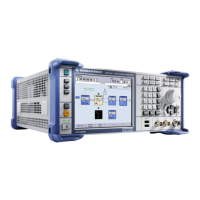Instrument Function
R&S
®
SMBV100A
181Operating Manual 1176.8016.02 ─ 17
5.3.3.3 Constellation Diagram
In the constellation diagram, the Q component is also displayed over the I component.
However, only the values at the constellation points (signal value at the ideal scanning
instant of the symbol) are displayed, i.e. for each symbol only 1 value in the form of a
circle is shown for the I and Q component.
The amplitudes of the signal components scaled to the peak envelope power (PEP)
are plotted on the X and Y axis (minimum scaled amplitude = -1; maximum scaled
amplitude = +1). The recording depth is 2kSamples.
This signal is picked off at the output of the baseband main module ("Impairment" func-
tion block), i.e. contained in the displayed signal is:
●
impairment of the signal as defined by the user and the addition of noise.
This display shows the various states of modulation mapping which occur in the signal.
The example shows the constellation diagram of a QPSK modulation signal.
5.3.3.4 Eye Diagram
The eye diagram displays synchronized and superimposed sections of either the
inphase or quadrature components of the signal.
The display width (eye length) is set at 2 symbols; several hundred curve segments
are superimposed. The time (in the range -/+ 1 symbol) is plotted on the X axis, and
the amplitude scaled to the peak envelope power (PEP) is plotted on the Y axis (mini-
mum scaled amplitude = -1; maximum scaled amplitude = +1). The beginning of
recording is synchronous to the symbol and chip clock pulse. The recording depth is
2kSamples.
This signal is picked off at the output of the baseband main module ("Impairment" func-
tion block), i.e. contained in the displayed signal is:
●
impairment of the signal as defined by the user and the addition of noise.
Graphical Display - Graphics

